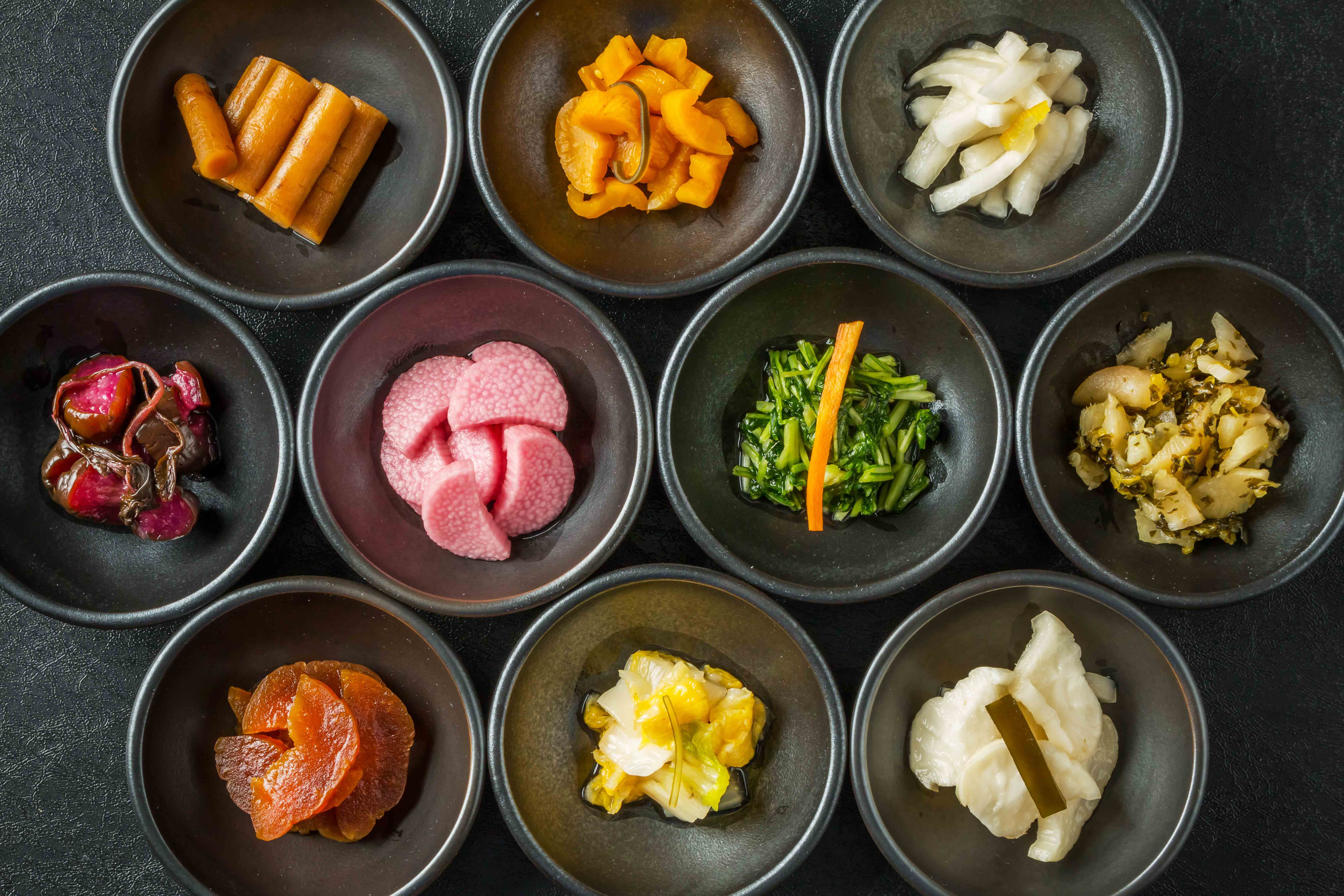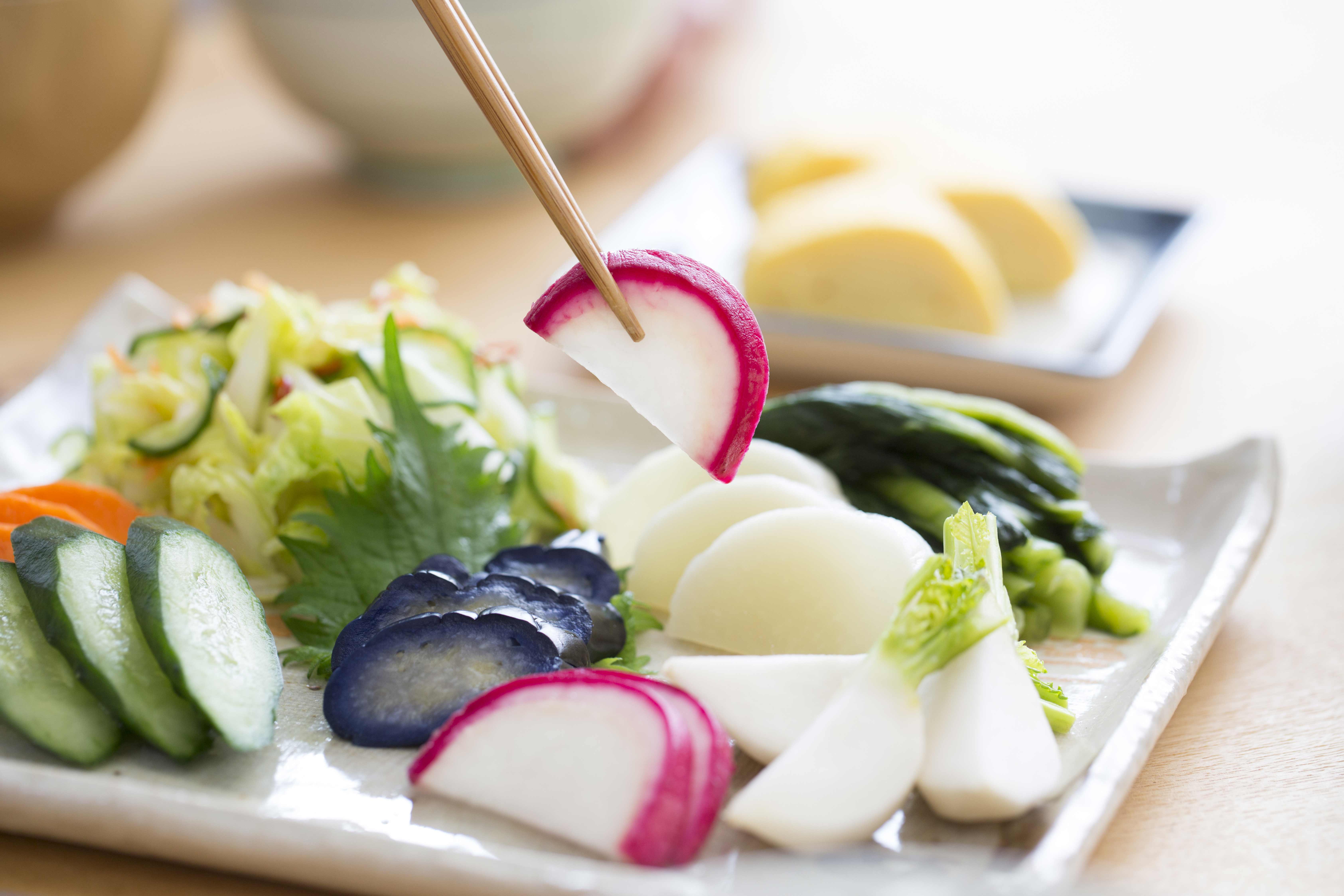“Pickles” is one of cooking methods of marinating vegetables and other foods with salt, vinegar, miso, or sake lees (It’s called “Sake kasu”, is the leftover bits from the “Japanese Sake” making process). By this soaking, it is said to lower the pH value of the food and block out air, which increases its shelf life and ripens it to enhance its flavor. Some other cooking ways of “Pickles” involve “fermentation”. This cooking way is a well known as method of preserving food not only in Japan but also in other countries, isn’t it? There are so many different types of pickles in the world. “Japanese Pickle” is a very important part of Japanese food culture. Well, it is usually called “O-Tsukemono” or “Koh-no-mono” in Japanese. You will probably see them at least once when you eat in Japan, because they are almost always served as a side dish, especially for set meals and set meals.
Not only “Pickles”, but so-called preserved foods have their own unique flavor or tastes in various parts of the world. It goes without saying that the ingredients used are different depending on the climate of each region. It’s probably because the preparation and pickling procedures are different, and the seasonings and spices added are different. Since food preservation way is an integral part of our daily lives, each region has its own unique characteristics. In Japan, there are many many unique pickles all over the country, and we hope you enjoy them. Oh, remember. Many pickles are high in salt, so be careful not to eat too much!
Typical “Japanese pickles”

※The word “zuke” means “soaking” or “marinating” in Japanese.
・Asa-zuke
It is a pickle made by soaking vegetables in salt, vinegar, broth, or other seasoning for a short time. It takes only a few hours to a few days to soak, and it is easy to prepare, it is often made in homes. Special seasoning solutions and other products are also available on the market, and you can make as much as you like using your favorite vegetables.
・Nuka-zuke
“Nuka” refers to rice bran. It is a kind of pickles made by soaking vegetables in lactic acid fermented rice bran (In Japanese, it is called “nukadoko”). One theory says that pickles using rice bran were made before the Middle Ages, but the current process of producing Nuka-zuke was not established until the Edo period (1603-1868). It is a very interesting cooking method, which we will explain in detail in another article.
・Tamari-zuke
Tamari-zuke is a pickle made by pickling vegetables once in salt to preserve and enhance their taste, removing the salt, and then soaking them in tamari or soy sauce. Daikon radish, eggplant, cucumber, and rakkyo are often used as ingredients.
※Tamari:The juice extracted by squeezing miso.
・Iburi-zuke
It is a rare type of pickles that includes a smoking process in the production process. Iburi-zuke made in Akita Prefecture is famous. Because of the heavy snowfall in this area, it was difficult to dry daikon radishes and other vegetables, so they were first made by smoking them indoors over an open hearth. Iburi-zuke is made by smoking daikon radish, carrots, etc., and then marinating them in nuka(salted rice bran).
・Wasabi-zuke
It is made by finely chopping wasabi roots, leaves and stems and pickling them in sakekasu. The unique flavor of sakekasu and the pungency of wasabi are very characteristic of this pickle. It is a specialty of Shizuoka and Nagano prefectures, known as wasabi production areas.
※Sakekasu:The white solid material that remains after pressing sake or other malt.
・Umeboshi
Nowadays, pickled plums, including those that are simply pickled in salt or seasoning solution, are also recognized as umeboshi and are widely distributed in general. However, umeboshi is originally made by further drying the pickled plums. It is one of the most representative Japanese pickles. And it is one of the traditional pickles with a very long history, so we will introduce in detail in another article.
・Shiba-zuke
Shiba-zuke is made from eggplant, cucumber, green pepper, shiso, etc. pickled in salt and fermented with lactic acid. It is well known as one of the Kyoto pickles. The word “柴(shiba)” originally comes from the word “紫葉(violet leaves)”, and the reddish-purple color of the pickles is beautiful. Many of the products in general circulation today are pickled in Shibazuke-like seasoning.
・Senmai-zuke
The pickles are thinly sliced turnips pickled in vinegar and are one of the representative Kyoto pickles. It was originally made by lactic acid fermentation of salted turnips, but now vinegar-pickled ones are commonly distributed. As the name suggests (Senmai: meaning a thousand pieces), it is characterized by the use of extremely thinly sliced turnips.
・Suguki-zuke
It is a pickle made with sugukina, a variety of turnip. Suguki-zuke is made by lactic acid fermentation of salted sughkina. It is said that this pickle has been made since before the Edo period, and is considered one of the representative Kyoto pickles along with Shiba-zuke and Senmai-zuke.
・Takuan-zuke
It is made of dehydrated daikon radish that has been dried in the sun or pickled in salt, and then pickled in a sweet and salty solution made of salt, mirin, soup stock, and other ingredients. Along with pickled plums, it is one of Japan’s most popular pickles. It has long been made in many parts of the country, and there are many variations. Some Takuan-zuke, made using traditional methods, have become local specialties.
・Bettara-zuke
It is the famous pickles of Tokyo. Bettara-zuke is made by pickling daikon radishes in salt to remove water, then soaking them in sugar, rice malt, and other ingredients.
・Nara-zuke
This pickle is made by pickling gourd, cucumber, ginger, etc. in salted water and then marinating them in sakekasu. It has a very long history and was made around the 8th century. It is a specialty product of Nara Prefecture. It is characterized by the distinctive sweet fermentation smell and taste of sakekasu.
・Takana-zuke
Pickles made from takana, a variant of the karashina(mustard plant), are specifically called Takana-zuke. There are two types of Takana-zuke: one is a lightly pickled type, and the other is pickled until it matures and lacto-ferments. The latter has a unique flavor and is used in fried rice, mixed rice, and stir-fried dishes. Takana-zuke, stir-fried with chili peppers, is also known as a topping for tonkotsu ramen. Yamagata Prefecture’s local pickle includes Seisai-zuke, a pickle made from seisai, a type of takana.
・Nozawana-zuke
Nozawana-zuke is a pickle made from nozawana. Nozawana, as well as takana, is a member of the Brassicaceae family and is one of the specialties of the Shinetsu region. Like Takana-zuke, Nozawana-zuke is available in two types: a lightly pickled type and a type pickled until it matures and undergoes lactic acid fermentation. Both are more refreshing and have less fermented smell than takana pickles.
・Hiroshimana-zuke
It is a pickle made using Hiroshimana as an ingredient. It is one of the specialties of Hiroshima Prefecture.
・Sankai-zuke
Sankai-zuke is made by pickling herring roe with cucumber, radish, etc. in sakekasu and aging them. It is one of the local dishes of Niigata Prefecture.
・Tsubo-zuke
It is made from chopped dried daikon radish pickled in soy sauce, and is a typical pickle in Kagoshima and other southern Kyushu regions.
・Fukujin-zuke
Vegetables used in Fukujin-zuke include radish, eggplant, nattamame, lotus root, cucumber, shiso seed, and shiitake mushroom. This pickle is made by pressing these vegetables with salt, removing the salt, chopping them into small pieces, and then marinating them in a seasoning solution of soy sauce, sugar, and mirin. Fukujin-zuke is often served as a garnish when ordering curry and rice in Japanese restaurants. It is popular for its moderate sweet and salty taste and crunchy texture.
※Fukujin: It means “seven gods of good fortune” and is said to derive from the fact that seven different ingredients were used.
・Gari
Gari is a familiar pickle as a side dish for sushi. It is thinly sliced ginger marinated in sweet vinegar. It can be light yellow without coloring or light pink with coloring.
・Beni-shoga
This pickle is made by soaking ginger in ume (plum) vinegar and is characterized by its colorful bright red color. It is often used as an ingredient in takoyaki and okonomiyaki. In addition to noodle dishes such as yakisoba and hiyashi-chuka, pickles are often seen as an accompaniment to chirashizushi and gyudon(beef bowls).
・Nishin-zuke
It is a pickle made by marinating daikon, carrots, cabbage, etc. cut into strips and Migaki-nishin(dried herring) with salt and rice malt. A local dish from Hokkaido to Tohoku and Hokuriku regions.
・Matsumae-zuke
Matsumae-zuke is made by soaking kazunoko mushrooms, shredded surume seaweed, and kelp in mirin and soy sauce. It is a well-known local dish of the Hokkaido – Tohoku region.
※Kazunoko:Herring Ovaries
・Oki-zuke
This dish is made by soaking seafood (squid, horse mackerel, etc. are well-known examples) in a seasoned broth made by boiling soy sauce and sake. The one, made with Hotal ika(firefly squid) from Toyama Prefecture, is famous.
・Shiokara
This dish is made from raw, salted and fermented seafood meat and offal. Squid, octopus, shrimp, krill, and sardines are mainly used as ingredients. Salted krill is similar to shrimp paste, which is also eaten as a seasoning in other East Asian countries.




